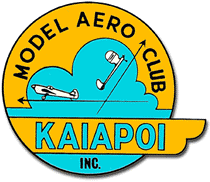Learning radio control flying can be an exciting start to a fascinating life-long hobby, or it can be a costly and frustrating exercise if the beginner does not get on the right track. As in most pastimes the key to success is getting the right gear and advice from the word Go!
The best way to get this is to call us or come and see us at the club – you will get a warm welcome, free helpful advice, and you can have a trial flight on our dual control club trial flight plane with a certified instructor for $10 a flight.
We will advise you on the right type of model to start with (VERY IMPORTANT!), the right type of engine, and recommend the most suitable radio gear appropriate to your aims and your budget. Another good source of help is your local model shop – FlightRC as an example.
At the Kaiapoi Model Aero Club our main interest is powered flight, so this is the area I will cover here.
Here is some general advice for the beginner: –
The typical trainer model is designed to be stable and easy to fly, with some self-correcting abilities built in.
To be suitable as a trainer a model is preferred to have a high wing, with a flat bottom wing section, and a reasonable amount of dihedral (i.e. the wings form a shallow V shape when viewed from the front of the plane). You can purchase and build a kit, or you can get an ARF kit, that is a kit where all the building and covering is done for you, and you just have some simple assembly to do.
Either way, if you are not sure what to buy or how to proceed then feel free to contact us for advice.
Models are usually classed by the size of their engine, and the most popular size is the 40, (for .40 cubic inch). These trainers are around the 1.6-to-1.75-meter wingspan (62-70″) which is a good size for stability and for visibility (they get very small very quickly in the air!). An important advantage is that the motor is common size for the sort of models that you will graduate to once you are past the training stage.
The radio gear should be a minimum of 4 channels. For many fliers that are learning this will be enough, however if you think that you will take model flying for the future, it is very wise to consider a radio transmitter that has 6 or 8 channels which allow for future models that may have retracting wheels, flaps, or other such features later then you may need more. The basic 4 channels control the throttle, the elevator (up and down), the ailerons (bank left or right), and the rudder. A popular make is Spektrum. The controls can be set up in several different ways e.g. the throttle can be controlled by the right stick (mode 1) or the left stick (mode 2). Make sure you match the mode of your instructor. Kaiapoi fliers are mostly mode 1.
That was a very basic guide to what you need. The main purpose is to stop beginners from wasting money buying unsuitable equipment and ending up frustrated. So don’t be shy – come and see us before purchasing anything.
This is doubly important with 2nd hand gear.
The best time to visit the field if you’re wanting more information is either on a Sunday or a Friday. Flying is available any day of the week for members with their wings, but the majority of the instructors will be there on Sunday’s, or Friday and available to answer your questions or give you an introduction flight. Mid-morning is usually a good time on a fine day, but if unsure contact us to make sure someone will be there to meet you.
So – see you at the strip, and Happy Landings!

